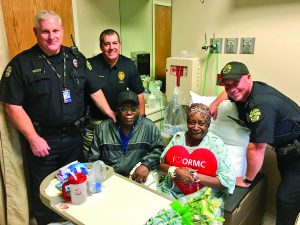Español Français Português عربى |

Ask any police officer to share with you something noteworthy he or she accomplished on the job this week and the answer you’re likely to hear is “nothing much.” But probe a little further and you’ll find an officer who used personal money to buy food and diapers for the mother who fled with her baby from domestic violence. An officer who, on a hot summer day, pulled up behind a teenager who had a flat tire on the side of a highway and helped get the young driver away from that dangerous situation. Or an officer who helped an elderly woman across a crosswalk in a hectic shopping center.

To your patrol officers, these moments are all part of their regular days. But, to the public, who isn’t exposed to what it’s like to walk in an officer’s shoes, these moments matter greatly. What we as a profession need to intently focus upon is ensuring our stories are told. Not just the heroic stories of running into the line of fire—those are the easy stories to tell, and the media is eager to cover those stories. It’s the more subtle moments that need to be shared on a consistent basis. Social media is the perfect place for opportunities like these.
It’s our job as police leaders to ensure that our agency members know that capturing these moments matters. It will always be challenging to combat negative narratives created by use-of-force incidents caught on camera and narrated by those who don’t know what can sometimes be required to bring a suspect under control. What we as a profession can improve upon is sharing the stories that humanize the men and women who devote so much of themselves to what is very often a thankless job. Supervisors are in the best position to hear about these daily positive encounters and should elevate these moments to the department’s public information officer. Ultimately, this directive needs to come from the top. Police leaders who advocate for working closely with the media and support social media programs send a message to all who work for them that this is the way we are doing business, so jump on board.
What we as a profession can improve upon is sharing the stories that humanize the men and women who devote so much of themselves to what is very often a thankless job.
Should you want guidance on how to do this, we have resources for you here at the IACP. For starters, this month’s issue of Police Chief is devoted to the critically important topic of media relations. Additionally, we have a Public Information Officers Section with PIOs from across the United States who have handled a wide variety of situations, both positive and negative. We are happy to connect you with section leadership should you have any public messaging questions or need guidance on managing a particular incident. We value our relationship with the media and working with them in order to get the word out about our profession. To that end, we recently hired a broadcast journalist turned law enforcement media relations director as part of our senior leadership team. Julie Parker is our senior advisor for media relations and can guide your agencies through best practices for engaging with your communities and the media to put your agencies in the best possible light. Please feel free to call upon our valued resources here at the IACP to ensure the public is aware of all the hard work your officers are putting in day in and day out. It’s time they get the proper recognition for their service to society. 🛡
Please cite as:
Paul M. Cell, “Telling Our Story Has Never Been More Important,” President’s Message, Police Chief (August 2019): 6-7.


